Trends and Insights to Innovate | article | Sunday, May 21, 2023
ABSURD BRANDS FOR UNREAL TIMES

The feeling of living in irreality has not gone away since the beginning of the pandemic and will persist in time. The chain of extraordinary environmental, economic, and social circumstances has turned the context into something fragile and strange, with no logical explanations. People are moving away from the initial bewilderment, resulting from the loss of sensible references, to the acknowledgement that they will be able to live with a certain lack of explanation. Accepting nonsense will be a useful strategy to get through the years to come. Individuals will build alternative narratives that allow them to make sense of chaos. Designing appealing and original brand narratives offering a unique guide to navigate turbulences has become relevant.
At present, explaining the economy is hard to explain and confusion has spread among analysts. “It’s harder than usual to read the economy because we’re still in such an odd period,” Karen Dynan, a Harvard economist and former Treasury Department official in Barack Obama’s administration, told The New York Times. The important takeaway is that pundits in the media no longer hide that difficulty in understanding what is going on and where the market is headed. “The problem with the current economy is that the numbers don’t make any sense,” stated Kevin T. Dugan in New York Magazine. A sense of loss of control over the factors that bring certainty to daily life is spreading among people. One out of three people in the U.S., Russia, Brazil and Germany said: “I feel that things in my country are out of control at the moment” (Global Risks Report, WEF). Economic complications are added to other global events that alter reality, such as climate change, with hundreds of catastrophic events in recent months that have alerted the population (droughts, fires, floods); and the war in Europe which produces a humanitarian crisis translated into shocking and painful news, as well as restrictions in supply chains and the consequent increase in prices of some commodities.
Critical reflections on the future of society have begun to emerge in recent times, encouraged by events that have shaken people, sowing confusion, and debunking beliefs. The Venezia Art Biennial, curated by Cecilia Alemani, took the name “The Milk of Dreams”, a direct inspiration from Leonora Carrington’s book “The Milk of Dreams”, which explores the metamorphosis of the human being from a surrealist perspective. The themes addressed by the artists capture the current moment in which the very survival of the species is threatened: How is the definition of human changing? What constitutes life? What are our responsibilities to the planet and other people? And what would life be like without us? There is no unanimous answer but different ideas —some very discordant with each other— about the future.
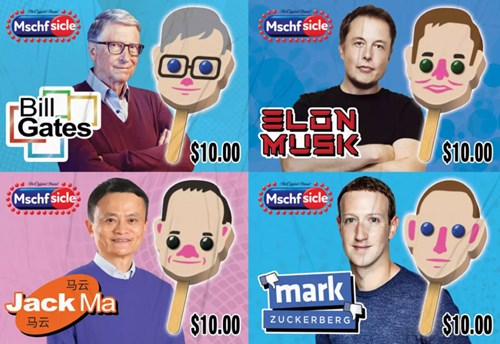
We witness the final dismantling of the great cultural narratives that used to order reality and provide a frame of reference for people’s actions. There is no longer an ethic that encompasses a majority, but one that has fragmented into multiple moral precepts and social beliefs that wage a regular battle with each other. Everything is debatable, everything is suspect, everything is manipulable. A distrustful, shrewd, and ironic gaze extends to challenge reality. The art collective MSCHF designed Eat the Rich popsicles, featuring the faces of the world’s wealthiest and most celebrated businessmen, so that people can symbolically eat them. Each wrapper details the image of an entrepreneur along with their brand logo, including Mark Zuckerberg, Bill Gates, Elon Musk, Jeff Bezos and Jack Ma. In a context of irreality, collections are impregnated with humor, irony, self-assurance, and rebelliousness to empathize with the spirit of the times.
The boundaries between fiction and reality are beginning to feel increasingly blurred. Hasbro and 3D printing company Formlabs launched ‘Selfie Series’, a customization service that gives collectors the opportunity to create a six-inch action figure with their faces and physiognomic features. Through the ‘Hasbro Pulse’ app, fans can scan their face and customize their character. Once submitted, Formlabs 3D prints the figure in resin and delivers it to their home. The price is $60 and includes iconic characters such as G.I. JOE, Power Rangers, Ghostbusters, and Marvel characters, among others. In lieu of finding logic in an illogical world, brands can add a fictional aspect to everyday life through storytelling. Disney’s Magical Companion is a new voice assistant that integrates with Amazon’s Echo smart speakers anddisplays. The idea is that the voices of favorite Disney, Pixar and Star Wars characters accompany people in their daily lives by playing during common tasks performed by the voice assistant, such as timers, alarms, and weather reports. In addition, the fictional characters can propose entertainment activities with special stories and games that families can play together. The user never knows which character will respond to their query: Dory from Finding Nemo, Olaf from Frozen or Mater from Cars, among others. The personalized assistant is activated by saying “Hello, Disney” and coexists with Alexa’s voice.
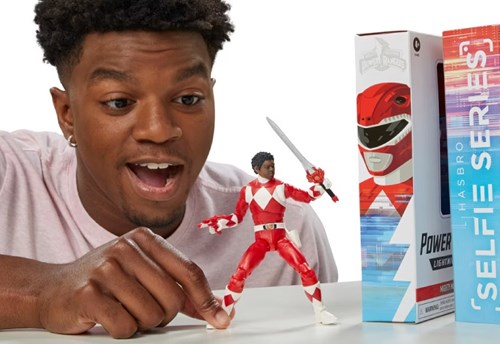
If the present times have become a field for extraordinary scenarios, then a useful strategy could be to integrate what’s unusual and absurd into brand experiences. Tripp is an immersive meditation experience accessible through a virtual reality application that encourages users to focus on their breathing while viewing appealing images that stimulate the senses and enhance mindfulness. The proposal, which requires the use of an Oculus, uses surreal stimuli to awaken feelings of awe, an emotional response that, according to some recent studies, can improve a person’s well-being. The app proposes different scenarios, from natural environments such as a mountain peak or a beach with out-of-the-ordinary details, as well as journeys through wavy, geometric, and hyper-colored works of art, something comparable to the use of hallucinogenic drugs. At the end of each session, users spend a few minutes floating in fictitious galaxies bathed in warm hues, a sensation that several astronauts have reported as one of awe and mental calm.
In such an erratic environment, there are many ways to develop novel proposals and stand out faced with competitors. A good strategy is to find fun in a situation out of one’s control. For example, some experiences play with luck to get certain advantages. The Japanese train company West Japan Railway (JR West) offers “Saikoro Kippu” tickets, with random destinations that passengers learn about after they are purchased. The train ticket is purchased through a phone app and a virtual dice roll decides some of the 7 possible destinations. The tickets save between 45% and 82% off the regular price.
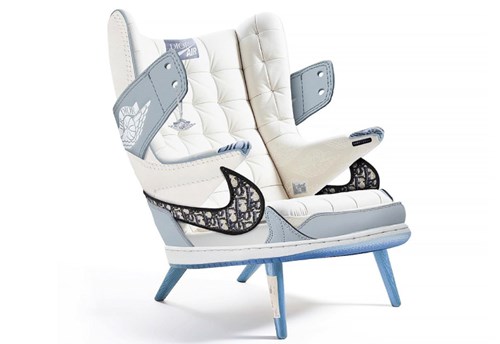
Suspending the sense elicited by current events empowers and legitimates the use of imagination. A kind of digital hallucination multiplies through the Internet. The integration of more advanced GenAI tools is giving room to an aesthetic and narrative that has its own rules outside reality. The recent fictional yet hyper-realistic image of the Pope walking through the Vatican dressed in a Monclear coat sparked fascination and astonishment at a massive scale. The possibility of creating homemade science fiction with GenAI’s tools at our fingertips allows us to express an infinity of unprecedented imaginaries that use symbology, images, sounds and texts with no biases. We are entering a new era of creative speculation. Thousands of creators are drafting extraordinary product ideas on platforms such as Midjourney, Syable Diffusion, Canvas or Dream Studio. Marco Rambaldi designed the 'hype chairs' series combining classic furniture with sneaker culture. Using AI, the artist adds a unique twist to iconic pieces such as The Eames Lounge Chair and Ottoman by Herman Miller with Nike swooshes, Air Jordan logos, and shoelace details.
In this uncertain scenario, people use a constellation of small, contradictory, and random senses that allow them to cope with everyday life. A heterogeneity of philosophies, beliefs, and affirmations —traditional or alternative— serve to find transient purposes. The need to make sense of the eclecticism of references and surrounding information encourages the emergence of narratives that integrate rational and mystical elements. Digital artist Lu Yang explores a world beyond reality by blending the science fiction aesthetics of anime and video games with Buddhist philosophy. The virtual becomes attractive for its ability to transcend normative ideas of self, i.e., gender, age, nationality, and provoke endless reinvention. Present in many of his works is the Buddhist idea that all things “will arise, remain, change and disappear,” in other words, “all things flow.” Brands will have to have the ability to capture and play dynamically with these eclectic and transversal micro-senses to diverse audiences.
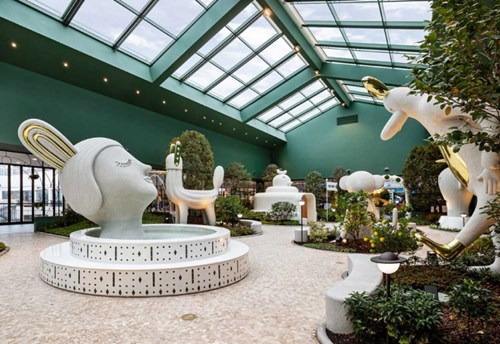

People are beginning to accept that living in an environment that escapes their understanding can be an opportunity to look for reading clues outside the known. In their eagerness to find incentives, individuals explore new meanings in fictitious universes. Jaime Hayon designed Hyundai Moka Garden, a series of cultural spaces that promote literacy and imagination among the residents of Namyangju, South Korea. In the library, visitors can seamlessly transition from an in-book learning to an in-person experience by interacting and exploring the indoor garden. The space, equipped with huge playful sculptures surrounded by a vibrant mural, inspires creativity and imagination in both children and adults.
Evasive scenarios for cohesive experiences are gaining ground. Gucci Town, Gucci’s new metaverse destination in the Roblox video game, invites players to participate in activities and tours as well as learn about the accessories collections. Organized around a central square, the virtual neighborhood invites users to discover the history of the brand guided by the kaleidoscopic vision of A. Michele. After the successful “Gucci Garden”, an experience visited by 19 million players in 14 days on the same platform, the project continues the line of creating surreal, immersive, and gamified stories to capture the public’s attention. To leverage on the fact that people want to navigate unusual and exciting proposals, brands can develop metaverse environments where customers can choose how to try the products through different fictional stories. The Clinique Lab is a new digital brand experience accesible to shoppers from anywhere in the world via website and mobile. Users can create an avatar to explore a virtual storefront, shop, interact with consultants, and obtain cosmetics details. Consumers can research product ingredients, formulation, benefits and application technique through interactive elements and explorative storytelling.
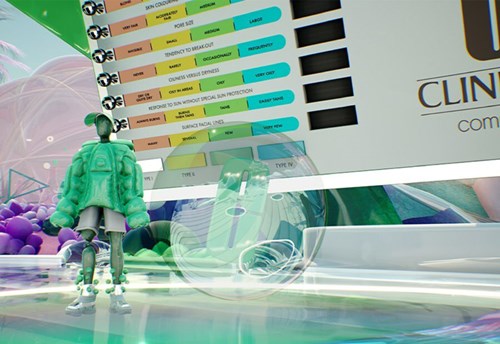
A scenario where inexplicable situations occur is apt for thinking outside the box and adding eccentricity to the everyday. Rapper Tommy Cash, together with artist Gab Bois, has created a sofa and a rug inspired by loaves of bread for a surrealist living room. The design, titled Loafa, has been publicly proposed on social media to IKEA for consideration for future production. Consumers are more receptive to connect with imagery, inspirations, and novel formats that surprise and challenge perceptions. Spaces that capture the public’s attention by disarticulating perceptions sprout. The Hyper-Haus studio designed the Doctor Mek Clinic in Bangkok as an art gallery where patients abstract from reality and dream of being “the best version of themselves”. The colorful, whimsical and absurd design provides a considerable amount of visual stimuli to keep the public entertained while they wait their turn for procedures that can be painful and anxiety-inducing.
The acceptance and celebration of the absurd, the extraordinary, and the incoherent open the door to unique reflections. Open-ended questions will drive the speculations of open minds. Games that deliberately seek to disrupt routines are on the rise. Play, by Urs Fischer, is a kinetic art experience that invites viewers to interact with office chairs that react unexpectedly when they detect human movement thanks to A.I. When approached, the objects react with different personalities: one may move away and try to hide in the corner, another may accelerate towards the person or simply stand still, ignoring your presence altogether. The work encourages people to explore the unexpected behavior of reality inside an empty room at the Tel Aviv Museum of Art.
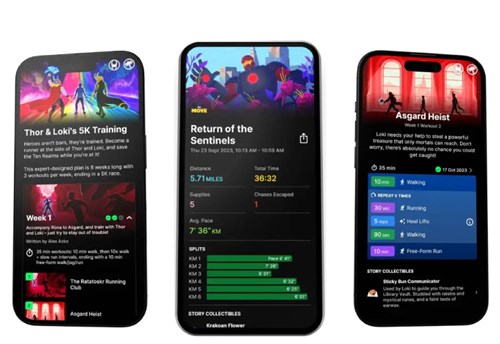
The moment has come to envision stores and events as surreal experiences that allow for limitless hedonism. Creating moments where consumers experience feelings of euphoria to bring the brand more vividly to life. Stimulating the senses in an unusual way to provoke unbridled emotions that allow people to release tensions. Marvel Move is a new mobile fitness app that features immersive audio-based running routines with popular Marvel Comics characters. The app -developed by Marvel and Six to Start- offers five ongoing storylines for users to choose from. For example, “The Hulk: Hulkville” involves running from the authorities, and Bruce and Betty Banner trying to hide Hulk from the world. In “X-Men: Age of ORCHIS”, listeners are recruited to work with the X-Men in Krakoa to take down mutand kind.
In a context where logic has blown away, the creation of unusual products and services tempts audiences. It is a rich ground for encouraging the design of hybrid categories of products with diverse functionalities and occasions of use, and for engaging in unexpected dialogs with other industries to create joint offers generating new typologies. Salt & Straw launched an edible ice-cream perfume with scents created to supplement classic ice-cream flavors. The culinary perfume can be sprayed on the body or on ice-cream as a topping for a multisensory experience. Several flavor and fragrances are offered, such as “A Cloud of Cocoa”, with notes of smoky chocolate and Japanese whiskey; “A Plume of Blooms”, that merged honeysuckle and jasmine; or “A Swoon of Citrus”. inspired by key lime pie. A good strategy is taking products to unusual fields to push the limits of creativity and surprise our own and potential audiences. Human Nature, by NewTerritory studio, is a futuristic concept of a psychedelic drug inhaler in microdoses, for when the substances are legalized for mental health treatment. The proposal explores how psilocybin, the psychoactive compound produced by hallucinogenic mushrooms, and lysergic acid diethylamide (LSD) could be consumed in small, regular doses to improve well-being.
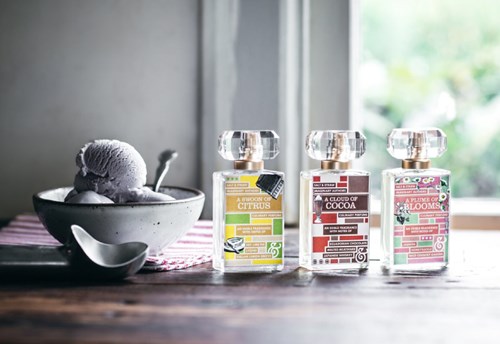
An uncertain, meaningless scenario sets people to live what is yet to be explored. Brands can benefit from this new behavior creating energetic and witty narratives that manage to weave stories, messages, offers, and extraordinary experiences to transport individuals to universes they have never experienced before. The brand can become a utopia in itself, capable of exciting the public. Combining rational, mystical, and absurd elements to tinge products and the customer journey with an extraordinary halo.
Pictures courtesy of MSCHF, Hasbro, Salt & Straw, Marco Rambaldi, Hyundai, Clinique & Marvel.
